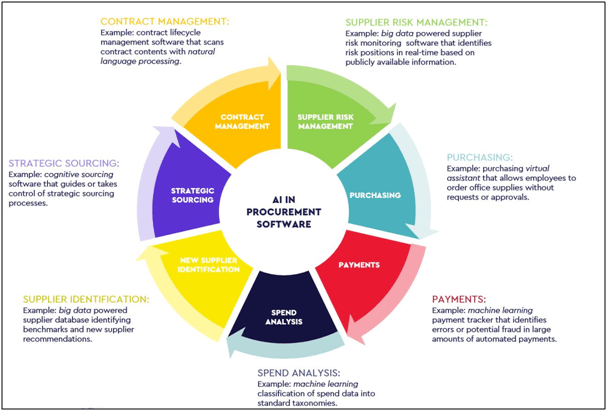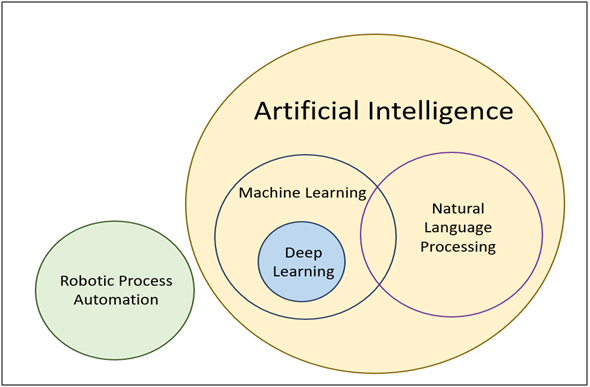Artificial Intelligence (AI) is one of the digital technologies progressing rapidly and is a current topic of broad interest. AI has contributed to a more efficient and intelligent way of streamlining business operations, which helps companies achieve cost reduction, improve efficiency and productivity and improve responsiveness to market demand.
This article aims to look into the crucial applications of AI in procurement, namely in the area of spend analytics, strategic sourcing and contract management, supplier risk management and robotic process automation (RPA) in procure-to-pay workflow. The chart below shows the applications of AI across Procurement Cycle.

Table of Contents
Understanding Artificial Intelligence
Artificial intelligence (AI) is a technology capable of performing tasks that typically require human intelligence by learning, coming to its own conclusions, understanding complex data, engaging in natural dialogues with people, enhancing human cognitive or replacing people on execution of non-routine tasks. These machines are programmed to rationalise like a human being and imitate human behaviours. The ideal characteristic of AI is to solve complex tasks better or more efficiently than humans.
Machine Learning (ML) and Natural Language Processing (NLP) are subsets of AI as illustrated in the diagram below. ML is a branch of AI where computer systems are given the ability to learn from large amounts of data without explicitly being programmed. There are four types of ML and they are: supervised learning, unsupervised learning, reinforcement learning and deep learning. NLP is another branch of AI that deals with the interaction between computers and humans using natural language.
While Robotic Process Automation (RPA) offers procurement many opportunities to improve process efficiency, it is not considered as AI. For simplicity, RPA is a software robot that automates repeatable tasks which human beings perform, while AI performs tasks that require human intelligence.

In the context of procurement, AI is a software solution that includes machine learning and smart algorithms aimed at resolving a specific task. AI automates and improves many time-consuming tasks, giving management additional insights based on extremely complex and large sets of data.
Types of Data Analytics
Data analytics is the practice of reviewing data to reduce cost and improve efficiency. The process involves collecting, cleansing, classifying and analysing spend data. It is one of the key tools used by procurement to identify savings opportunities, manage risks and optimise the organization’s buying power.
As illustrated in the diagram below, there are four types of data analytics, namely:
• Descriptive Analytics is the interpretation of historical data to understand what has happened. It includes finding out who spent how much, with whom, and on what product. Examples of descriptive analytics are reports that provide historical insights regarding the company’s purchases, production, operations, sales, finance, inventory and customers.
• Diagnostic Analytics focuses on why something happened. It could be broken down into a three-step process of first identifying anomalies in the data, then collecting data related to anomalies and finally explaining the anomalies using statistical techniques such as drill down, data discovery and data mining, to find relationships and trends. An example is how a company can use diagnostic analytics to understand the cause of overstocking or stockout.
• Predictive Analytics, as the term suggest, predicts what might happen based on insights from descriptive and diagnostic analytics. It incorporates statistical models and forecasting techniques to provide the company with actionable insights based on data, as well as to predict future trends. For example, predictive analytics is commonly used in demand forecasting. The accuracy of forecasting is highly dependent on the data quality and constancy of the situation.
• Prescriptive Analytics is the last phase of data analytics; it suggests the best strategy to take. Specific techniques used include optimization, simulation, game theory and decision-analysis methods. For example, predictive analytics is used to optimise production planning and inventory in the supply chain to ensure delivery of the right products at the right time, hence enhancing customer satisfaction.

AI in Spend Analytics
In procurement, spend analysis software with machine learning algorithms are widely used to improve and speed up processes such as automatic spend classification and vendor matching. For example, machine learning software can extract the procurement spend data from the system, classify them according to spend category (such as office supplies, software and packaging) and present the Category Spend Analysis data in the form of a pie chart or bar graph such as the one shown below.

This information provides management with insights on the amount of goods spent on the different categories and which spend category to prioritise for further analysis. By narrowing down to a specific spend category, management is better able to identify and forecast savings opportunities. Prioritisation will allow better negotiations with suppliers on key spend categories to ensure favourable contracts and pricing.
With a high-level overview of spend by category, it becomes easier to identify categories which delivers savings and realise projects which brings strategic importance to the organization. This data gives management insight into making strategic decisions for better resource optimisation and allocation.
AI in Strategic Sourcing
The machine learning software empower buyers with new ways to identify, manage and utilise supplier data across public and private databases. Platforms such as Tealbook uses advanced AI to improve sourcing by having better insights into existing supplier’s capabilities and relationships with your company, tracing supplier’s performance by enabling stakeholder to rate and provide feedback on suppliers, expanding supplier base, qualifying new suppliers that meet business requirements and leveraging on community knowledge via referrals and recommendations of endorsed suppliers.
AI can also be used to manage and automate sourcing events. One example is Keelvar’s sourcing optimisation software. This software help buyers to identify global sourcing opportunities using the internet. It allows users to identify the most strategic and beneficial outcome by performing trade-off analysis (such as weighing the cost of using costlier suppliers against the potential cost of natural disaster), building collaborative relationships with suppliers, allowing for competitive and innovative bids and real time unlimited scenario analysis.
AI in Contracts Management
Natural language processing function in AI enables software to scan and interpret lengthy legal documents. The software can simplify the contract analysis process by extracting and identifying critical business and legal terms from corporate agreements and highlight it to users. It enables business and legal users to better understand and manage risks, obligations, and revenue opportunities embedded within the contracts.
AI in Supplier Risk Management
With the use of AI, computers can identify, access and mitigate potential risk positions across the supply chain. Risk method’s Risk Intelligence is an example of a supply chain risk management solution that uses AI to monitor millions of sources for new and emerging risks proactively. For example, when there is an earthquake in Japan, AI will be able to detect the potential disruptions caused by this event and relate it to the supply chain. It will then alert the management in real time, enabling them to take the necessary actions to mitigate the impact of this event on their business.
The full content is only visible to SIPMM members
Already a member? Please Login to continue reading.
References
Jacob Karmehag and Erik Lofnertz. (2018). “How Digital Technologies will Impact the Procurement Process and Organisation”. Retrieved from https://pdfs.semanticscholar.org/c9f2/c5aac4a3376ca81e341110ca97933cf1cfb2.pdf, accessed 04/12/2019.
Jasmine Tan, ADLSM (2019). “Cold Chain Excellence through Data Analytics”, Retrieved from SIPMM: https://publication.sipmm.edu.sg/cold-chain-excellence-through-data-analytics/, accessed 05/12/2019.
Laserfiche. (2019). “What Is Robotic Process Automation?”. Retrieved from: https://www.laserfiche.com/ecmblog/what-is-robotic-process-automation-rpa/, accessed 05/12/2019.
Nurazyyati Jaffar, ADPSM. (2018). “The Future of Procurement with Artificial Intelligence”. Retrieved from SIPMM: https://publication.sipmm.edu.sg/future-procurement-artificial-intelligence/, accessed 05/12/2019.
Rich Wilson. (2019). “Looking back and moving forward: The past, present and future of e-sourcing”, Retrieved from https://blog.keelvar.com/2019/09/10/e-sourcing-past-and-future-rich-wilson-keelvar/, accessed 05/12/2019.
Riskmethods. (2019). “Supply Chain Risk Management Software”. Retrieved from https://www.riskmethods.net/products-services/riskmethods-solution, accessed 05/12/2019.
Scoutbee. (2019). “3 Procurement Challenges Facing Digital Transformation in 2019”. Retrieved from: https://scoutbee.com/procurement-challenges-2019/, accessed 05/12/2019.
Sievo (2019). “AI in Procurement”, Retrieved from: https://sievo.com/resources/ai-in-procurement, accessed 04/12/2019.
STS News Deck (2019). “Seal Software Announces Version 7 Of Award-Winning AI-Based Contract Analytics Platform”, Retrieved from: https://www.salestechstar.com/productivity-enablement/contract-e-signature/seal-software-announces-version-7-of-award-winning-ai-based-contract-analytics-platform/, accessed 05/12/2019.
Tealbook. (2019). “Meet Our Procurement Platform”, Retrieved from: https://tealbook.com/procurement/, accessed 05/12/2019.

